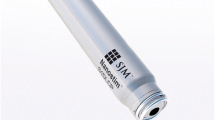Abstract
The development of Leadless cardiac pacemakers avoids the inherent complications that may occur secondary to lead insertion. A large number of devices have been inserted in adult patients although data in pediatric patients are lacking. We aimed to assess our experience with the Leadless device in the pediatric population. We performed a retrospective study on all pediatric patients who underwent insertion of a Leadless pacemaker in our center. Data were collected for demographic, procedural, and outcome variables. Nine patients with a median (IQR) age and weight of 13 (12–14) years and 37 (31–50) kg, respectively, were enrolled. The median (IQR) procedural time was 62 (60–65) min with insertion thresholds of 0.5 (0.35–1) Volts at 0.24 ms. All devices were successfully inserted without complication. One device was replaced with a single-lead endocardial pacemaker at 1 year for increased thresholds. Leadless pacemaker device insertion is feasible in pediatric patients. Further studies and long-term follow-up are needed to ascertain device longevity and complication rates.
Similar content being viewed by others
References
Jaeggi E, Laskin C, Hamilton R, Kingdom J, Silverman E (2010) The importance of the level of maternal anti-Ro/SSA antibodies as a prognostic marker of the development of cardiac neonatal lupus erythematosus a prospective study of 186 antibody-exposed fetuses and infants. J Am Coll Cardiol 55(24):2778–2784
Ayyildiz P, Kasar T, Ozturk E, Ozyilmaz I, Tanidir IC, Guzeltas A et al (2016) Evaluation of permanent or transient complete heart block after open heart surgery for congenital heart disease. Pacing Clin Electrophysiol 39(2):160–165
Cohen MI, Rhodes LA (1998) Sinus node dysfunction and atrial tachycardia after the Fontan procedure: the scope of the problem. Seminars in thoracic and cardiovascular surgery. Pediatric Cardiac Surg Annu 1:41–52
Glatz AC, McBride MG, Paridon SM, Cohen MS, Walker SA, Gaynor JW et al (2010) Long-term noninvasive arrhythmia assessment after surgical repair of sinus venosus atrial septal defect. Congenit Heart Dis 5(2):141–148
Murayama H, Maeda M, Sakurai H, Usui A, Ueda Y (2008) Predictors affecting durability of epicardial pacemaker leads in pediatric patients. J Thorac Cardiovasc Surg 135(2):361–366
Hauser RG, Hayes DL, Kallinen LM, Cannom DS, Epstein AE, Almquist AK et al (2007) Clinical experience with pacemaker pulse generators and transvenous leads: an 8-year prospective multicenter study. Heart Rhythm 4(2):154–160
Carreras EM, Duncan WJ, Djurdjev O, Campbell AI (2015) Cardiac strangulation following epicardial pacemaker implantation: a rare pediatric complication. J Thorac Cardiovasc Surg 149(2):522–527
Sandrio S, Purbojo A, Toka O, Dittrich S, Cesnjevar R, Ruffer A (2016) Transmural placement of endocardial pacing leads in patients with congenital heart disease. Ann Thorac Surg 101(6):2335–2340
Wilhelm BJ, Thone M, El-Scheich T, Livert D, Angelico R, Osswald B (2015) Complications and risk assessment of 25 years in pediatric pacing. Ann Thorac Surg 100(1):147–153
Duray GZ, Ritter P, El-Chami M, Narasimhan C, Omar R, Tolosana JM et al (2017) Long-term performance of a transcatheter pacing system: 12-month results from the Micra Transcatheter Pacing Study. Heart Rhythm 14(5):702–709
Piccini JP, Stromberg K, Jackson KP, Laager V, Duray GZ, El-Chami M et al (2017) Long-term outcomes in leadless Micra transcatheter pacemakers with elevated thresholds at implantation: results from the Micra transcatheter pacing system global clinical trial. Heart Rhythm 14(5):685–691
Grubman E, Ritter P, Ellis CR, Giocondo M, Augostini R, Neuzil P et al (2017) To retrieve, or not to retrieve: system revisions with the Micra transcatheter pacemaker. Heart Rhythm 14(12):1801–1806
Saleem-Talib S, van Driel VJ, Chaldoupi SM, Nikolic T, van Wessel H, Borleffs CJW et al (2019) Leadless pacing: going for the jugular. Pacing Clin Electrophysiol 42(4):395–399
Welisch E, Cherlet E, Crespo-Martinez E, Hansky B (2010) A single institution experience with pacemaker implantation in a pediatric population over 25 years. Pacing Clin Electrophysiol 33(9):1112–1118
Gomes S, Cranney G, Bennett M, Giles R (2016) Long-term outcomes following transvenous lead extraction. Pacing Clin Electrophysiol 39(4):345–351
Patel B, Garg J, Chaudhary R, Sablani N, Gupta R, Shah M et al (2018) His bundle pacing: hemodynamics and clinical outcomes. Cardiol Rev 26(4):201–206
Afzal MR, Daoud EG, Cunnane R, Mulpuru SK, Koay A, Hussain A et al (2018) Techniques for successful early retrieval of the Micra transcatheter pacing system: a worldwide experience. Heart Rhythm 15(6):841–846
Kiani S, Merchant FM, El-Chami MF (2019) Extraction of a 4-year-old leadless pacemaker with a tine-based fixation. HeartRhythm Case Rep 5(8):424–425
Li J, Hou WB, Cao MK, Zhou WX, Wang Y, Fang Y et al (2019) Safety and efficacy of leadless pacemaker retrieval. J Cardiovasc Electrophysiol. https://doi.org/10.1111/jce.14076
Funding
This study has no financial disclosures.
Author information
Authors and Affiliations
Corresponding author
Ethics declarations
Conflict of interest
One of the authors Lisa Dunne is an employee with Medtronic. All other authors have no conflict of interest to disclose.
Ethical Approval
All procedures performed in the study involving human participants were in accordance with the ethical standards of the institution and the na1964 Helsinki declaration and its later amendments.
Additional information
Publisher's Note
Springer Nature remains neutral with regard to jurisdictional claims in published maps and institutional affiliations.
Rights and permissions
About this article
Cite this article
Breatnach, C.R., Dunne, L., Al-Alawi, K. et al. Leadless Micra Pacemaker Use in the Pediatric Population: Device Implantation and Short-Term Outcomes. Pediatr Cardiol 41, 683–686 (2020). https://doi.org/10.1007/s00246-019-02277-y
Received:
Accepted:
Published:
Issue Date:
DOI: https://doi.org/10.1007/s00246-019-02277-y




